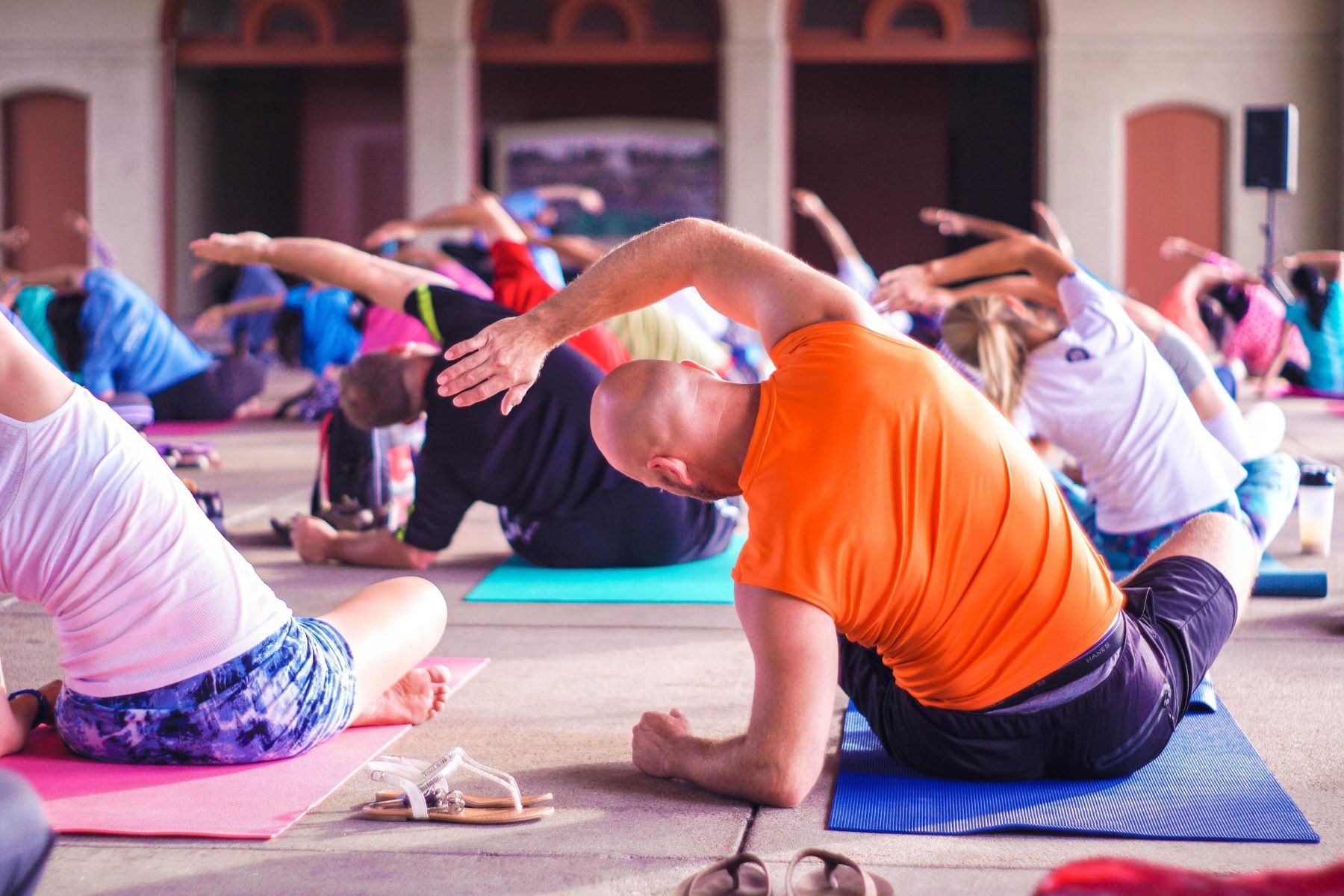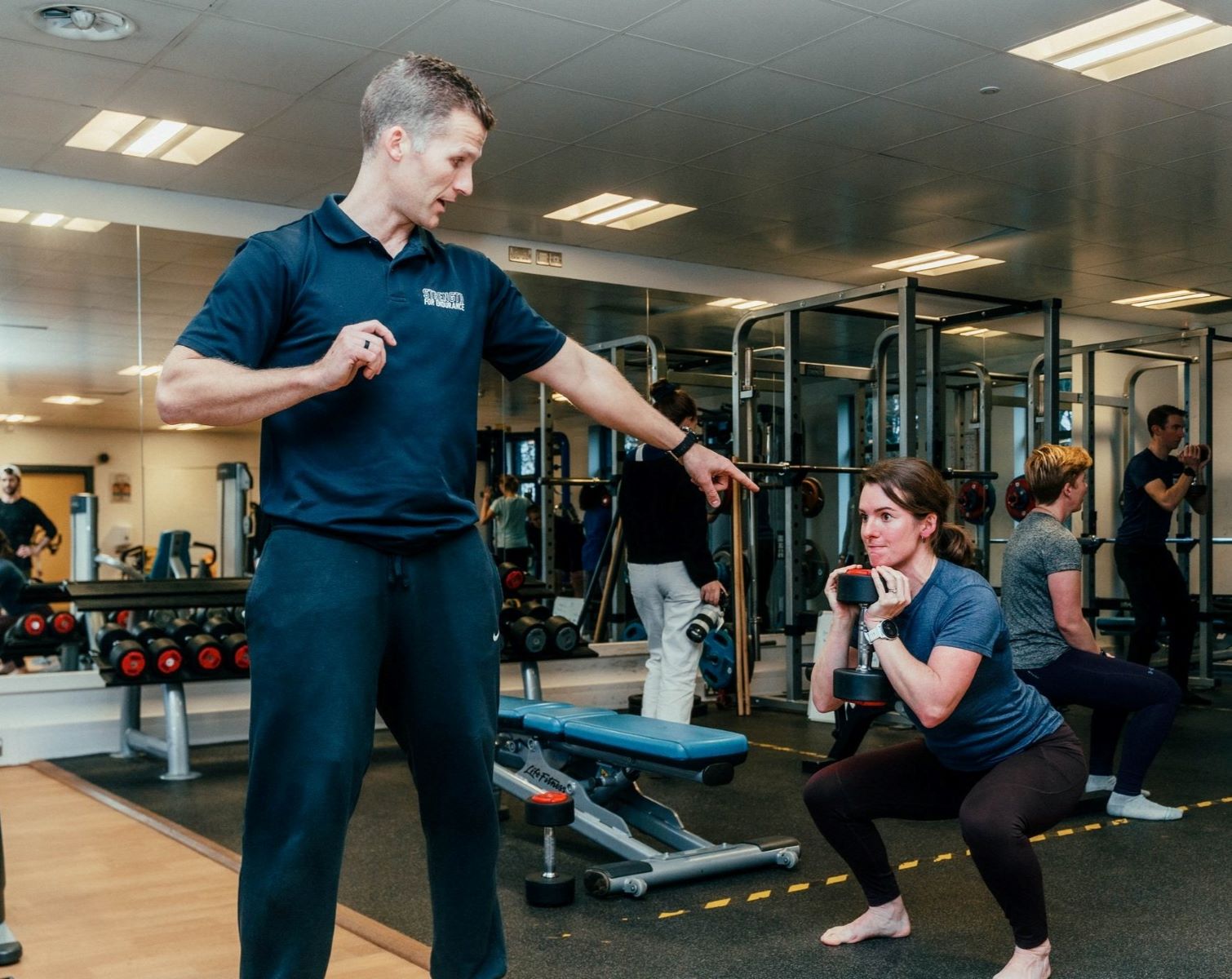Home>Misc>Featured>How To Improve Cardiorespiratory Endurance


Featured
How To Improve Cardiorespiratory Endurance
Modified: October 24, 2023
Featured: Discover effective strategies to improve your cardiorespiratory endurance and boost your overall fitness level. Enhance your cardiovascular health with these expert tips.
Introduction
Cardiorespiratory endurance, also known as cardiovascular endurance, refers to the ability of the heart, lungs, and blood vessels to deliver oxygen and nutrients to the muscles during prolonged physical activity. This essential component of overall fitness plays a crucial role in maintaining good health and achieving optimal performance in various activities.
With our modern sedentary lifestyles and increasing prevalence of chronic diseases, improving cardiorespiratory endurance has become more important than ever before. Engaging in regular exercise and adopting a healthy lifestyle can have a significant impact on our cardiovascular system, leading to numerous health benefits and a higher quality of life.
This article will explore the importance of cardiorespiratory endurance, the factors affecting it, and provide practical tips on how to improve and enhance this aspect of fitness. Whether you are a beginner looking to start a fitness journey or an athlete seeking to optimize your performance, this article will provide valuable insights to help you improve your cardiorespiratory endurance levels.
It is important to note that while this article aims to provide general information and guidance, it is always recommended to consult with a healthcare professional or a certified fitness trainer before starting any new exercise or fitness program, especially if you have any underlying health conditions or physical limitations.
Importance of Cardiorespiratory Endurance
Cardiorespiratory endurance is a vital component of overall fitness for people of all ages and fitness levels. Here are some key reasons why improving and maintaining good cardiorespiratory endurance is important:
- Improved Heart Health: Regular aerobic exercise, which strengthens the heart and improves its efficiency, is a cornerstone for maintaining a healthy cardiovascular system. It lowers the risk of heart diseases, such as heart attacks, strokes, and high blood pressure.
- Enhanced Stamina and Energy Levels: When your cardiorespiratory endurance improves, you will notice a significant increase in your stamina and energy levels. This means you’ll be able to engage in physical activities for longer durations without feeling fatigued.
- Weight Management: Engaging in cardio exercises helps burn excess calories and promotes weight loss. By incorporating cardiorespiratory endurance exercises into your fitness routine, you can effectively manage your weight or achieve your weight loss goals.
- Mental Health Benefits: Regular aerobic exercise stimulates the release of endorphins, often referred to as “feel-good” hormones. This can help alleviate symptoms of stress, anxiety, and depression, leading to improved mental well-being.
- Improved Lung Function: Cardiorespiratory endurance exercises help improve lung capacity and efficiency by strengthening the respiratory muscles. This allows for increased oxygen intake and improves the body’s ability to expel carbon dioxide.
Moreover, having good cardiorespiratory endurance positively impacts our daily lives as it enables us to handle everyday tasks with ease. Simple activities such as climbing stairs, carrying groceries, or playing with children become less demanding when our cardiovascular system is in good shape.
By improving your cardiorespiratory endurance, you can also enhance your athletic performance. Whether you’re a runner, cyclist, swimmer, or participate in team sports, having a strong cardiovascular system will allow you to perform at your best for longer periods and recover faster between intense bouts of exercise.
Now that we understand the importance of cardiorespiratory endurance, let’s explore the factors that can affect this aspect of fitness and how we can assess our current fitness level.
Factors Affecting Cardiorespiratory Endurance
Cardiorespiratory endurance is influenced by a variety of factors, both intrinsic and extrinsic. Understanding these factors can help us identify areas for improvement and develop strategies to enhance our cardiorespiratory endurance. Here are some key factors that can affect cardiorespiratory endurance:
- Genetics: Our genetic makeup plays a significant role in determining our baseline level of cardiorespiratory endurance. Some individuals may have a natural predisposition to better cardiovascular health and higher endurance levels, while others may have to put in extra effort to achieve similar results.
- Age: As we age, our cardiorespiratory endurance tends to decline naturally. However, regular exercise can help mitigate the age-related decline and maintain optimal cardiovascular fitness.
- Body Composition: A higher percentage of body fat can negatively affect cardiorespiratory endurance. Excess weight puts additional strain on the cardiovascular system, making it more difficult to perform physical activities without fatigue.
- Training and Exercise Habits: Consistency and adherence to a well-rounded exercise program are key factors in improving and maintaining cardiorespiratory endurance. Regular aerobic exercises, such as running, cycling, swimming, or dancing, help condition the heart and lungs and enhance endurance levels.
- Intensity and Duration of Exercise: Engaging in exercise at the appropriate intensity and duration is crucial for improving cardiorespiratory endurance. Gradually increasing the intensity and duration of workouts challenges the cardiovascular system and promotes adaptations that lead to improved endurance.
- Diet and Nutrition: Proper nutrition plays a significant role in supporting cardiorespiratory endurance. Consuming a well-balanced diet that includes a variety of nutrient-rich foods provides the necessary fuel for energy production during exercise. A diet rich in fruits, vegetables, whole grains, lean proteins, and healthy fats can help optimize endurance performance.
- Rest and Recovery: Sufficient rest and recovery are essential for allowing the body to repair and adapt to the stresses of exercise. Inadequate rest can lead to overtraining, which can hinder cardiorespiratory endurance improvement and increase the risk of injuries.
- Environmental Factors: Climate, altitude, and air quality can impact cardiorespiratory endurance. Exercising in a challenging environment, such as high altitude or extreme heat, can stimulate adaptations that improve endurance levels over time.
It’s important to note that while these factors can influence cardiorespiratory endurance, they are not limitations. With proper training, nutrition, and lifestyle modifications, anyone can improve their cardiorespiratory endurance levels regardless of their starting point.
Now that we understand the factors affecting cardiorespiratory endurance, it’s essential to assess our current fitness level before embarking on a training program. This will help us set realistic goals and track our progress effectively. In the next section, we will explore various methods for assessing our cardiorespiratory fitness.
Assessing Current Fitness Level
Before beginning any fitness program, it is crucial to assess your current cardiorespiratory fitness level. This assessment will provide a baseline measurement of your endurance and help you set achievable goals for improvement. Here are some common methods for assessing your cardiorespiratory fitness:
- Cardiorespiratory Fitness Tests: There are several standardized fitness tests available that can assess your cardiorespiratory fitness. The most common one is the VO2 max test, which measures the maximum amount of oxygen your body can utilize during intense exercise. Other tests, like the 12-minute run or walk test or the 3-minute step test, can also provide a good estimation of your cardiovascular fitness.
- Heart Rate Monitoring: Monitoring your heart rate during exercise can provide valuable insights into your cardiovascular fitness level. You can measure your resting heart rate, maximum heart rate, and track how quickly your heart rate recovers after exercise. The resting heart rate can be an indicator of your overall cardiovascular health and fitness.
- Perceived Exertion: Another subjective method to assess your cardiorespiratory fitness is through the Borg Rating of Perceived Exertion (RPE) scale. This scale allows you to rate your perceived effort during exercise on a scale from 6 to 20, with 6 being no exertion at all and 20 being maximal exertion. Monitoring your RPE throughout your workouts can help gauge your fitness level and adjust the intensity of your exercises accordingly.
- Functional Fitness Tests: Functional fitness tests, such as the 3-minute step test, 1-mile walk test, or the Cooper test, assess your ability to perform everyday activities that require cardiorespiratory endurance. These tests measure how efficiently your cardiovascular system can handle physical tasks and provide a practical evaluation of your endurance.
It is important to keep in mind that these assessments provide an estimation of your current cardiorespiratory fitness level and should be used as a starting point for setting fitness goals. Tracking your progress over time by repeating these assessments periodically can help you evaluate the effectiveness of your training program and make necessary adjustments.
Once you have assessed your current fitness level, you can now set goals for improving your cardiorespiratory endurance. In the next section, we will explore effective strategies and techniques to enhance your endurance levels and achieve your fitness objectives.
Setting Goals for Improvement
Setting clear and realistic goals is crucial when it comes to improving your cardiorespiratory endurance. Having specific targets to work towards can help you stay motivated and track your progress effectively. Here are some tips for setting goals that will aid in your endurance improvement journey:
- Be Specific: Instead of setting vague goals like “improve endurance,” be specific about what you want to achieve. For example, you could set a goal to be able to run 5 kilometers without stopping or complete a cycling race within a certain time frame.
- Make It Measurable: Set goals that can be measured objectively. This could include improving your running pace by a certain amount or increasing the distance you can swim without taking a break.
- Set Realistic Targets: It’s important to set goals that are challenging yet achievable. Consider your current fitness level, lifestyle, and any limitations you may have. Setting unrealistic goals can lead to frustration and demotivation.
- Break It Down: Break your larger endurance goals into smaller, manageable milestones. This will make your journey more attainable, and each milestone achieved will serve as motivation to keep going.
- Establish a Timeline: Set a timeline for reaching your goals. Having a deadline can provide a sense of urgency and keep you focused on your training plan.
- Include Both Short-Term and Long-Term Goals: Incorporate goals that can be achieved within a few weeks or months, as well as goals that may take several months or even years to accomplish. This will help maintain motivation and provide a sense of achievement along the way.
- Make Your Goals Personal: Your goals should align with your individual interests and preferences. Choose activities that you enjoy and want to excel in, whether it’s running, cycling, swimming, or participating in a specific sport or fitness event.
- Write It Down: Document your goals in a journal or use a goal-tracking app. Writing down your goals helps solidify your commitment and serves as a reminder of what you are working towards.
- Regularly Evaluate and Adjust: Regularly assess your progress and adjust your goals if needed. As you improve your cardiorespiratory endurance, your goals may need to be revised to continue challenging yourself.
Remember, the journey to improving cardiorespiratory endurance is a personal one. Focus on your own progress and avoid comparing yourself to others. With well-defined goals and a plan in place, you are well on your way to reaching new levels of endurance and fitness.
In the next sections, we will explore various aerobic exercise techniques, interval training methods, strength training exercises, and other strategies to enhance your cardiorespiratory endurance.
Aerobic Exercise Techniques
Aerobic exercises are an essential component of improving cardiorespiratory endurance. These exercises use large muscle groups and increase your heart rate and breathing, helping to strengthen your cardiovascular system. Here are some effective aerobic exercise techniques to incorporate into your training regimen:
- Running: Running is a popular and accessible aerobic exercise that can be done outdoors or on a treadmill. Start with a comfortable pace and gradually increase your distance or speed over time. Interval running, alternating between periods of high-intensity sprints and recovery jogs, can also be an effective way to boost your endurance.
- Cycling: Cycling is a low-impact aerobic exercise that can be done outdoors or on a stationary bike. It targets the leg muscles and provides an excellent cardiovascular workout. You can vary the intensity by adjusting the resistance or incorporating interval training, such as cycling at a high intensity for a certain duration followed by a recovery period.
- Swimming: Swimming is a full-body, low-impact exercise that is gentle on the joints. It engages multiple muscle groups simultaneously and provides a challenging cardiovascular workout. Incorporate different strokes and intensities to keep your swim sessions diverse and effective.
- Dancing: Dancing is a fun and enjoyable way to improve cardiorespiratory endurance. Whether it’s Zumba, hip-hop, salsa, or any other dance style, following the moves and keeping up with the rhythm can provide a great aerobic workout. Attend dance classes or dance along with online tutorials to get your heart rate up and improve your endurance.
- Brisk Walking: Walking at a brisk pace is a simple yet effective way to improve cardiorespiratory endurance. Aim for a pace that elevates your heart rate and takes you out of your comfort zone. You can increase the challenge by incorporating hills or using a weighted vest to add resistance.
- Aerobic Classes: Joining group fitness classes, such as aerobic or step classes, can be a great way to stay motivated and enjoy a variety of aerobic exercises. These classes often incorporate high-energy movements and music to keep you engaged and challenged.
When incorporating aerobic exercises into your routine, aim for a minimum of 150 minutes of moderate-intensity aerobic activity or 75 minutes of vigorous-intensity aerobic activity per week, as recommended by the American College of Sports Medicine (ACSM). Gradually increase the duration and intensity of your workouts to further enhance your cardiorespiratory endurance.
Remember to warm up before each aerobic session and cool down afterward to prevent injuries and properly recover. Choose activities that you enjoy and vary your workouts to keep them exciting and prevent boredom.
In the next section, we will explore interval training, which can be an effective method for improving cardiorespiratory endurance.
Interval Training for Endurance Improvement
Interval training is a powerful method for improving cardiorespiratory endurance. By alternating between periods of high-intensity exercise and active recovery, interval training pushes your cardiovascular system to adapt and become more efficient. Here’s how you can incorporate interval training into your endurance improvement strategy:
- Choose Your Activity: Select an exercise that allows you to easily adjust the intensity, such as running, cycling, rowing, or swimming.
- Warm-Up: Begin with a 5-10 minute warm-up at a moderate intensity to prepare your body for the upcoming high-intensity intervals.
- Work Interval: Push yourself to a high-intensity level for a specific period, such as 30 seconds to 2 minutes, depending on your fitness level. Increase your speed, resistance, or effort during this interval to challenge your cardiovascular system.
- Recovery Interval: Follow the work interval with an active recovery period of lower intensity exercise or complete rest. Allow yourself enough time to catch your breath and recover, usually around half the duration of the work interval.
- Repeat: Repeat the work and recovery intervals for a desired number of sets. Beginners may start with 4-6 intervals and gradually increase as they become fitter.
- Cool Down: Finish the session with a 5-10 minute cool-down at a lower intensity to gradually bring your heart rate back to normal and aid recovery.
Interval training can be modified to match your fitness level and goals. Here are a few interval training variations you can try:
- Tabata: This high-intensity interval training (HIIT) method consists of 20 seconds of all-out effort followed by 10 seconds of rest, repeated for a total of 4 minutes.
- Pyramid Intervals: Start with shorter work intervals and gradually increase their duration, then decrease them again. For example, you could start with 30 seconds, then progress to 45 seconds, 1 minute, and then decrease back down to 45 seconds and 30 seconds.
- Ladder Intervals: Begin with a shorter work interval and progressively increase its duration, then go back down. For instance, you could start with 30 seconds, then move to 45 seconds, 1 minute, 1.5 minutes, before decreasing back down to 45 seconds and 30 seconds.
Interval training can help improve your aerobic capacity, increase your endurance, and burn more calories compared to steady-state exercise. It also offers a time-efficient way to fit in a challenging workout within a shorter duration.
However, it’s important to listen to your body and gradually increase the intensity and duration of your intervals to prevent injury and avoid overexertion. If you’re new to interval training or have any underlying health concerns, consult with a fitness professional to ensure it’s appropriate for you.
In the next section, we will explore how strength training can complement and enhance your cardiorespiratory endurance.
Strength Training for Endurance Enhancement
While cardio exercises are essential for improving cardiorespiratory endurance, incorporating strength training into your fitness routine can complement and enhance your endurance performance. Strength training exercises help develop muscular strength, power, and muscular endurance, which in turn can improve your overall endurance capabilities. Here’s how you can incorporate strength training to enhance your endurance:
- Compound Exercises: Focus on compound exercises that engage multiple muscle groups simultaneously. Examples include squats, deadlifts, lunges, bench presses, and pull-ups. These exercises help improve overall functional strength, which translates to improved endurance in various activities.
- High Repetitions: Perform your strength training exercises with higher repetitions, typically in the range of 12-20 reps, to target muscular endurance. This helps train your muscles to sustain effort for longer periods, leading to improved endurance capabilities.
- Lower Weights: Use lighter weights that still challenge your muscles but allow you to complete the desired number of repetitions. The focus is on building muscular endurance rather than maximum strength.
- Rest Interval Lengths: Keep the rest intervals relatively short between sets, typically 30-60 seconds. This helps maintain an elevated heart rate and mimics the demands of continuous activity, promoting endurance adaptations.
- Circuit Training: Incorporate circuit training, which involves performing a series of exercises with minimal rest in between. This type of training keeps your heart rate elevated and combines both strength and cardiovascular challenges.
- Core Strengthening: A strong core provides stability and improves overall body control during endurance activities. Incorporate exercises such as planks, Russian twists, and bicycle crunches to strengthen your core muscles.
- Functional Movements: Include exercises that mimic the movements and demands of your specific endurance activities. For example, if you’re a runner, incorporate exercises that mimic the running motion, such as step-ups or single-leg squats.
It’s important to note that strength training should be seen as a supplement to your cardio training, rather than a replacement. Aim to include a balanced combination of strength and cardio exercises in your fitness routine to optimize your endurance enhancement.
When starting a strength training program, ensure proper form and technique to minimize the risk of injuries. If you’re new to strength training or unsure about proper technique, consider working with a certified strength and conditioning specialist or a personal trainer to learn the correct form and progress safely.
Now that we’ve explored strength training for endurance enhancement, let’s dive into the benefits of cross-training and how it can further improve your cardiorespiratory fitness.
Cross-Training for Cardiorespiratory Fitness
Cross-training refers to the practice of engaging in different types of exercise and activities to improve overall fitness and performance. Incorporating cross-training into your cardiorespiratory fitness routine can provide numerous benefits and help prevent overuse injuries. Here’s how cross-training can enhance your cardiorespiratory fitness:
- Variety of Movements: Cross-training involves different types of exercises, such as cycling, swimming, strength training, hiking, or practicing yoga. This variety of movements engages different muscle groups and challenges your cardiovascular system in unique ways.
- Improved Conditioning: By engaging in different activities, you’ll improve your overall conditioning and adaptability. This can help you become a more well-rounded athlete and better prepared for a variety of physical challenges.
- Injury Prevention: Cross-training reduces the risk of overuse injuries by decreasing repetitive stress on specific muscles or joints. By distributing the workload across different activities, you allow your body to recover and minimize the strain on specific areas.
- Mental Stimulation: The variety offered by cross-training keeps your workouts fresh and exciting. Trying new activities or switching up your routine helps combat boredom and keeps you mentally engaged, which can increase your motivation to exercise regularly.
- Enhanced Recovery: Cross-training can serve as active recovery on your rest days from high-impact or high-intensity exercises. Engaging in low-impact activities like swimming or practicing yoga can help improve blood circulation, reduce muscle soreness, and promote faster recovery.
- Improved Fitness Plateaus: If you’ve reached a plateau in your cardiorespiratory fitness progress, cross-training can help you overcome it. By introducing new activities and training stimuli, you challenge your body in different ways, breaking through stagnation and promoting continued improvement.
When incorporating cross-training into your fitness routine, consider the following tips:
- Plan a Schedule: Designate specific days or times for different activities to ensure proper planning and balance.
- Choose Complementary Activities: Select activities that complement your main cardio activity. For example, if you’re a runner, consider cross-training with cycling or swimming to engage different muscle groups.
- Listen to Your Body: Pay attention to how your body responds to different activities. Adjust the intensity or duration of each activity based on your energy levels and recovery needs.
- Progress Gradually: When adding new activities to your routine, start with shorter durations or lower intensities and gradually increase as your fitness level improves.
- Enjoy the Process: Embrace the variety and have fun with cross-training. Explore different activities and find what brings you joy while challenging your cardiorespiratory fitness.
Incorporating cross-training into your routine can help you achieve well-rounded cardiorespiratory fitness while reducing the risk of injuries and keeping you motivated. In the next section, we will explore the role of nutrition in enhancing endurance performance.
Proper Nutrition for Endurance Enhancement
Proper nutrition is essential for optimizing endurance performance and improving cardiorespiratory fitness. The right balance of macronutrients and adequate hydration can provide the fuel and nutrients needed to support your workouts and promote recovery. Here are some nutrition tips to enhance your endurance:
- Carbohydrates: Carbohydrates are the primary fuel source for endurance activities. Prioritize complex carbohydrates like whole grains, fruits, vegetables, and legumes, which provide sustained energy. Aim to consume a sufficient amount of carbohydrates to replenish glycogen stores and support endurance.
- Protein: Protein plays a crucial role in muscle repair and recovery. Include lean sources of protein like chicken, fish, tofu, beans, and Greek yogurt in your diet. Aim for a moderate protein intake to support muscle growth and repair.
- Fats: Incorporate healthy fats from sources like avocados, nuts, seeds, and olive oil. They provide sustained energy and help support overall health. Choose unsaturated fats and limit saturated and trans fats.
- Hydration: Proper hydration is vital for endurance activities. Drink fluids before, during, and after exercise to replace fluids lost through sweating. Monitor your urine color as a general indicator of hydration status – pale yellow to clear is a sign of adequate hydration.
- Pre-Workout Fuel: Consume a small meal or snack containing carbohydrates and a moderate amount of protein before longer endurance workouts. This will provide the necessary energy for optimal performance.
- During-Workout Fuel: For workouts lasting longer than an hour, consider consuming easily digestible carbohydrates such as energy gels, sports drinks, or fruits to maintain blood sugar levels and provide continuous energy.
- Post-Workout Recovery: Within 30-60 minutes after exercise, consume a balanced meal or snack containing carbohydrates and protein to replenish glycogen stores and support muscle recovery.
- Vitamins and Minerals: Ensure you’re getting a variety of vitamins and minerals through a balanced diet or consider incorporating a multivitamin supplement to support overall health and performance.
- Individualized Approach: Nutritional needs vary among individuals, so it’s important to listen to your body and experiment with different foods and timing to find what works best for you. Consulting with a registered dietitian specializing in sports nutrition can provide personalized guidance.
Remember, proper nutrition should be a consistent part of your lifestyle and not just focused around training sessions. Fuel your body with nutritious foods throughout the day to optimize endurance performance and overall health.
In addition to nutrition, rest and recovery are crucial components for optimizing endurance performance, which we will explore in the next section.
Rest and Recovery for Optimal Performance
Rest and recovery are vital components of any training program aimed at improving cardiorespiratory endurance. Giving your body adequate time to rest and recover allows for adaptations to occur, reducing the risk of injury and maximizing performance potential. Here are some key considerations for incorporating rest and recovery into your routine:
- Rest Days: Schedule regular rest days throughout the week to allow your body time to recover. Rest days should be active recovery or complete rest, depending on your needs and energy levels.
- Sleep: Aim for a consistent sleep schedule to ensure you get enough quality sleep. Sleep is essential for muscle repair, hormone regulation, and overall recovery.
- Active Recovery: Engage in low-impact activities such as leisurely walking, gentle stretching, or yoga on rest days. This helps improve blood circulation, promotes muscle relaxation, and accelerates recovery.
- Listen to Your Body: Pay attention to any signs of fatigue, pain, or excessive soreness. Pushing through intense fatigue or ignoring pain can lead to overtraining and increased risk of injuries. Adjust your training intensity and volume accordingly.
- Nutrition for Recovery: Consume a nutrient-rich meal or snack within the post-workout recovery window to help replenish glycogen stores and support muscle repair. Include a balance of carbohydrates and protein to optimize recovery.
- Hydration: Hydrate adequately before, during, and after exercise to replace fluids lost through sweat. Dehydration can hinder recovery and affect performance.
- Self-Care: Incorporate stress management techniques such as meditation, deep breathing exercises, or taking relaxing baths to help reduce physical and mental stress levels. This can promote faster recovery and overall well-being.
- Massage and Foam Rolling: Consider incorporating self-massage techniques or using a foam roller to help relax muscles, release tension, and improve mobility. These techniques can aid in muscle recovery and reduce muscle soreness.
- Gradual Progression: Allow for sufficient time to adapt to increasing training demands. Gradually increase the intensity, duration, or frequency of your workouts to minimize the risk of overtraining and promote sustainable progress.
Remember that rest and recovery are as important as the training itself. Ignoring the importance of rest can lead to overtraining, decreased performance, and an increased risk of injuries.
By incorporating proper rest and recovery strategies into your routine, you’ll optimize your performance, improve your cardiorespiratory endurance, and promote long-term health and well-being.
In the next section, we will discuss the importance of monitoring progress and adjusting your training plan to ensure continued improvement.
Monitoring Progress and Adjusting Training Plan
Monitoring your progress and adjusting your training plan is essential for continued improvement in cardiorespiratory endurance. By regularly assessing your performance, you can identify areas of strength and areas that may need improvement. Here are some key strategies for monitoring progress and making necessary adjustments:
- Track Your Workouts: Keep a record of your workouts, including the type of exercise, duration, intensity, and any notes on how you felt during the session. This will provide an overview of your training patterns and allow you to identify trends over time.
- Measure Indicators of Performance: Track objective indicators of your cardiorespiratory fitness, such as heart rate recovery time, running pace, cycling speed, or swimming time. Regularly measuring these indicators can help assess improvements in endurance levels.
- Use Fitness Apps or Wearable Devices: Utilize fitness apps or wearable devices that track your workouts, heart rate, and other performance metrics. These tools provide real-time feedback, allow for easy tracking, and provide insights into your progress.
- Periodic Fitness Assessments: Incorporate periodic fitness assessments, such as the VO2 max test or 1-mile run/walk test, to evaluate your cardiorespiratory fitness levels. Compare results over time to determine improvements or areas that require further attention.
- Listen to Your Body: Pay attention to how your body feels during and after your workouts. Notice any changes in energy levels, fatigue, or recovery time. Adjust your training plan accordingly if you consistently feel excessively fatigued or experience persistent muscle soreness.
- Set New Goals: Regularly assess your goals and set new ones to continue challenging yourself. As you progress, your goals may need to be adjusted to reflect your improved fitness level.
- Vary Your Workouts: Incorporate variety into your training plan to continue stimulating your cardiovascular system and prevent stagnation. Include different types of exercises, intensities, and training methods to keep your body challenged.
- Seek Professional Guidance: Consult with a certified fitness professional or a coach who specializes in endurance training. They can provide expert guidance, assess your progress, and make appropriate adjustments to your training plan.
- Listen to Feedback: Be open to feedback from others, such as training partners, coaches, or instructors. Their observations and insights can help you identify areas for improvement and make necessary adjustments.
Remember, progress in cardiorespiratory endurance is typically gradual. Be patient and stay consistent with your training and monitoring efforts. Celebrate small milestones along the way to maintain motivation and keep pushing towards your goals.
By regularly monitoring your progress and making necessary adjustments, you can continue to improve your cardiorespiratory endurance, achieve optimal performance, and maintain a sustainable training plan.
In the next section, we will wrap up the article with a summary of the key points discussed.
Conclusion
Improving cardiorespiratory endurance is a journey that requires commitment, patience, and a well-rounded approach. By implementing the strategies and techniques outlined in this article, you can enhance your cardiorespiratory endurance and unlock numerous benefits for your overall health and fitness. Let’s recap the key points discussed:
We started by understanding the importance of cardiorespiratory endurance and its impact on heart health, stamina, weight management, mental well-being, and overall daily activities. We then explored the various factors that can affect cardiorespiratory endurance, including genetics, age, body composition, training habits, nutrition, and environmental factors.
To assess our current fitness level, we discussed various methods such as cardiorespiratory fitness tests, heart rate monitoring, perceived exertion, and functional fitness tests. Setting realistic goals was emphasized, emphasizing the importance of specificity, measurability, and gradual progression.
We then delved into various aerobic exercise techniques, including running, cycling, swimming, dancing, brisk walking, and aerobic classes. Interval training was highlighted as an effective method to improve endurance by alternating between periods of high-intensity exercise and active recovery.
Recognizing the importance of strength training, we discussed how compound exercises, high repetitions, and lower weights can enhance muscular endurance. Cross-training was highlighted as a way to introduce variety, prevent overuse injuries, and improve overall conditioning.
Proper nutrition and hydration were emphasized as critical components for optimizing endurance performance. Consuming a balanced diet rich in carbohydrates, protein, healthy fats, and vitamins and minerals was recommended. Rest and recovery strategies, such as rest days, adequate sleep, active recovery, and self-care, were discussed to promote recovery and prevent overtraining.
Monitoring progress and making necessary adjustments were encouraged to ensure ongoing improvement. Strategies such as tracking workouts, measuring performance indicators, using fitness apps, periodic assessments, and listening to the body were highlighted.
In conclusion, improving cardiorespiratory endurance is a holistic process that encompasses various factors, including exercise, nutrition, rest, and monitoring. By implementing these strategies consistently and adapting them to your individual needs, you can enhance your cardiorespiratory endurance, achieve optimal performance, and improve your overall health and well-being.
Remember, always consult with a healthcare professional or certified fitness trainer before starting any new exercise program, especially if you have underlying health conditions or physical limitations. Stay committed, stay motivated, and enjoy the journey towards improved cardiorespiratory endurance!









